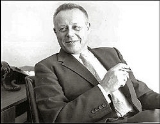
Karel Bossart
Encyclopedia

Wernher von Braun
Wernher Magnus Maximilian, Freiherr von Braun was a German rocket scientist, aerospace engineer, space architect, and one of the leading figures in the development of rocket technology in Nazi Germany during World War II and in the United States after that.A former member of the Nazi party,...
and Sergei Korolev but as most of his work was for the United States Air Force and therefore was classified he remains relatively little known.
After winning a scholarship - under the Belgian American Education Foundation - to M.I.T. to study aeronautical engineering he remained in the US working for various aircraft companies. In 1945 he was chief of structures at Convair
Convair
Convair was an American aircraft manufacturing company which later expanded into rockets and spacecraft. The company was formed in 1943 by the merger of Vultee Aircraft and Consolidated Aircraft, and went on to produce a number of pioneering aircraft, such as the Convair B-36 bomber, and the F-102...
and proposed to the USAF that a missile could be developed with an 8000km range based on the work of von Braun. The Air Force was skeptical of Bossart's proposal partly to preserve the priority of Strategic Bombers but he was granted a limited contract to develop the proposal. Bossart's major innovation was the use of a monocoque
Monocoque
Monocoque is a construction technique that supports structural load by using an object's external skin, as opposed to using an internal frame or truss that is then covered with a non-load-bearing skin or coachwork...
design in which structural support was maintained by pressure within the inelastic fuel tanks. After a series of tests in 1947 the Air Force lost interest and Bossart was instructed to abandon the research but by 1951 the escalation of the cold war enabled Bossart to revive the project that became known as 'Atlas'. In 1955 the CIA reported that the Soviets had swiftly progressed their own ICBM programme and Atlas became a crash project of the highest national importance. Bossart used this opportunity to advance work with high energy cryogenic fuels that resulted in the Centaur
Centaur (rocket stage)
Centaur is a rocket stage designed for use as the upper stage of space launch vehicles. Centaur boosts its satellite payload to geosynchronous orbit or, in the case of an interplanetary space probe, to or near to escape velocity...
upper stage.
Atlas was first launched in 1958 but was never fully effective as an ICBM. As a launch vehicle it has formed the basis of the most successful and reliable expendable rockets in service. As a result Bossart's achievements include:
- Launch of first communications satellite
- Launch of first US orbital manned missions
- Launch of MarinerMariner programThe Mariner program was a program conducted by the American space agency NASA that launched a series of robotic interplanetary probes designed to investigate Mars, Venus and Mercury from 1963 to 1973...
probes to MarsMarsMars is the fourth planet from the Sun in the Solar System. The planet is named after the Roman god of war, Mars. It is often described as the "Red Planet", as the iron oxide prevalent on its surface gives it a reddish appearance...
and VenusVenusVenus is the second planet from the Sun, orbiting it every 224.7 Earth days. The planet is named after Venus, the Roman goddess of love and beauty. After the Moon, it is the brightest natural object in the night sky, reaching an apparent magnitude of −4.6, bright enough to cast shadows... - Launch of Pioneer 10Pioneer 10Pioneer 10 is a 258-kilogram robotic space probe that completed the first interplanetary mission to Jupiter, and became the first spacecraft to achieve escape velocity from the Solar System. The project was managed by the NASA Ames Research Center and the contract for the construction of the...
and Pioneer 11Pioneer 11Pioneer 11 is a 259-kilogram robotic space probe launched by NASA on April 6, 1973 to study the asteroid belt, the environment around Jupiter and Saturn, solar wind, cosmic rays, and eventually the far reaches of the solar system and heliosphere...
to JupiterJupiterJupiter is the fifth planet from the Sun and the largest planet within the Solar System. It is a gas giant with mass one-thousandth that of the Sun but is two and a half times the mass of all the other planets in our Solar System combined. Jupiter is classified as a gas giant along with Saturn,...
and SaturnSaturnSaturn is the sixth planet from the Sun and the second largest planet in the Solar System, after Jupiter. Saturn is named after the Roman god Saturn, equated to the Greek Cronus , the Babylonian Ninurta and the Hindu Shani. Saturn's astronomical symbol represents the Roman god's sickle.Saturn,...
.
In 1955 Bossart became chief engineer of the Atlas project and in 1957 he was promoted to Technical Director of Aeronautics at General Dynamics. On December 17, 1957, eleven years of Bossart's work was climaxed by the successful first flight of the Atlas. On December 22, 1957, he appeared on What's My Line?
What's My Line?
What's My Line? is a panel game show which originally ran in the United States on the CBS Television Network from 1950 to 1967, with several international versions and subsequent U.S. revivals. The game tasked celebrity panelists with questioning contestants in order to determine their occupations....
as a guest credited as "Rocket Designer U.S.A.F. Atlas Missile".
In 1958 he received the Air Force's Exceptional Civilian Award for his work in developing America's first ICBM.
His co-workers called Bossart one of the finest technical men in the country. They credit him with having spearheaded a major phase in the art of rocketry.

